Even the most optimistic of observers can find little hope for a reprieve in the jackup market near-term. However, other segments of the North American offshore rig market are faring better.
Thomas E. Marsh, ODS-Petrodata, Inc.
ODS-Petrodata regularly generates a rolling forecast of offshore rig demand on a global and market segment basis, and the most recent forecast for the US jackup market is not rosy. Unless natural gas demand and prices increase, the working jackup count is unlikely to move significantly from its present dismal level.
CURRENT JACKUP MARKET STATUS
The Gulf of Mexico jackup market is in its worst state in years, with the number of working jackups falling from 54—itself a fairly dismal number in relation to the recent past—to just 19 between January and July 2009. The working rig count has not been this low since the industry’s early growth in the 1970s. In late 2007 and early 2008, it appeared that the US Gulf jackup market was on the rebound, but with the global economic crisis, the bottom fell out, and quickly at that. The working jackup count is now lower than it was during the devastating hurricane seasons of recent years, Fig. 1.
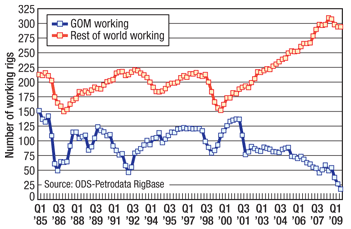 |
|
Fig. 1. Quarterly average working jackup count: US Gulf vs. rest of the world from 1985 to present.
|
|
However, the economic recession probably only accelerated a process that was in the works anyway. Well permits reflect the magnitude of the decline in activity in the US Gulf. In the first half of 2008, the US Minerals Management Service issued 302 offshore well permits; in the first half of this year, only 165 permits have been issued. Exploration drilling has been the hardest-hit segment in the current climate, leaving rig owners to battle for the few development drilling and workover jobs that arise. The US Gulf jackup market has been dependent on the price of natural gas, not oil, for years, and the comparison of gas prices with the region’s working jackup count in Fig. 2 drives home the point.
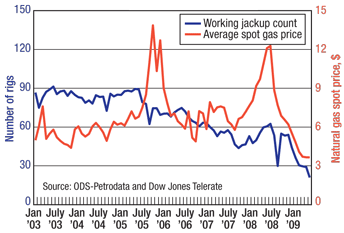 |
|
Fig. 2. US Gulf jackup count vs. natural gas price, January 2003 to June 20, 2009.
|
|
That said, some projects would be viable even at the current price of natural gas, as costs for rigs, support vessels and other services have come down. For some operators, the lack of available financing is holding things in check, while with others the issue is conservative budgeting in the face of the uncertain economic outlook.
Company views. Pride International summed up the situation in its first quarter results. “Deteriorating market conditions in the US Gulf of Mexico during the first quarter of 2009 resulted in a decline in revenues contributed by the company’s 20-rig mat-supported jackup fleet.”
“Customer spending in the US has seen a steep decline into early 2009 as natural gas prices remain below levels needed to create acceptable drilling economics in many areas, and access to credit remains difficult for many smaller, under-capitalized customers, resulting in a near-term environment of low utilization and day rates.” Pride also noted that inquiries had increased “somewhat” late in the first quarter, but that has not had any obvious effect on US Gulf jackup demand.
Similar observations have been made by the other players. Ensco International stated that reduced jackup demand is expected to continue for the “foreseeable future,” as several operators have postponed drilling programs until oil and natural gas prices recover. Ensco anticipates that the hurricane season will also bring about a small decline in jackup demand.
Diamond Offshore noted that “absent a sustained improvement in commodity prices, weakness in the GOM is likely to continue in 2009, with an increasing number of rigs being cold-stacked by the industry in an effort to help bring equipment supply and demand into equilibrium.”
Hercules Offshore tried to find a silver lining in its first quarter report. While noting the effect of weak commodity prices and the global credit crisis on the offshore rig market at present, Hercules said that steep production decline rates coupled with the decline in E&P activity could bring about increased demand for drilling services in the longer term.
Nabors Industries also found something positive in the current market, but not with regard to jackups. Nabors recorded an increase in domestic offshore operating results in the first quarter as a result of higher average day rates and utilization for its platform drilling and platform workover rigs.
In another sign of the times, Rowan Companies early in the year halted construction on one new jackup due to the downturn in jackup demand and the unsettled credit markets. However, in June the Houston-based driller said construction would recommence, “based on improvements in the credit markets and our confidence in our liquidity outlook through 2010.” The $150 million rig will be delivered in 2011, but Rowan will face challenges, as it will be just one of 43 new jackups that will join the global fleet over the next two years.
Day rates. Day rates, as a function of demand and fleet utilization, have weakened. Figure 3 charts day rates for selected US Gulf rig market segments. Average rates for jackups rated less than 300 ft have declined from $76,640 to $48,400 since the first of the year. Rates for deeper water-depth rated rigs followed suit. In the 300-ft independent-leg cantilever jackup segment, the average rate fell from $115,980 to $75,930, and average rates for the deepest water-depth jackups fell from $168,420 to $134,035 in the first six months of the year.
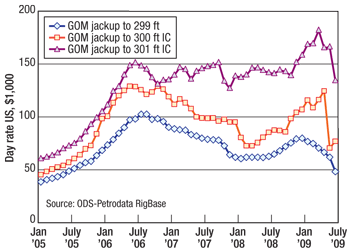 |
|
Fig. 3. Average US Gulf day rates for selected jackup classes earned rates, January 2005 to June 2008.
|
|
Even before the current downturn, jackups were leaving the US Gulf for greener seas, and many rigs remaining in the region are being marketed internationally. Figure 4 illustrates the overall decline in US Gulf jackup supply and demand in recent years. The US Gulf shallow water rig market has been given up for dead in the past, but it always staged somewhat of a recovery. However, the struggle to recover from the current hard-hit market will be much more difficult for rig owners than any previous effort.
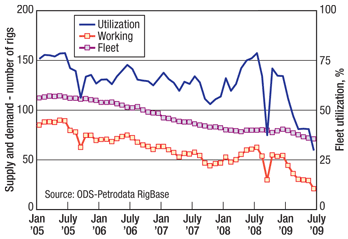 |
|
Fig. 4. US Gulf of Mexico jackup supply and demand, January 2005 to June 2009.
|
|
STRENGTH AFLOAT
Further offshore, demand for floating drilling units in the US Gulf has been relatively flat over the last year, and according to ODS-Petrodata’s short-term forecast, the working rig count and total fleet size will stay about the same through the end of 2009. If oil prices settle at levels that make operators comfortable, the number of floating rigs working in the region is expected to increase in the second quarter of 2010.
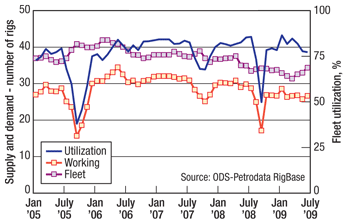 |
|
Fig. 5. US Gulf of Mexico floating rig supply and demand, January 2005 to June 2009.
|
|
The market has softened, however. According to our data, 10 US Gulf operators have 12 possible or probable floating rig drilling programs under consideration at present without a rig commitment, and most of these are for only one or two wells. One year ago, operators had some 50 drilling programs under consideration for which no rig commitments were in hand.
However, floating rig demand in the US Gulf and worldwide has exceeded supply for some time, particularly in the deepwater market. ODS-Petrodata’s forecast predicts that drillship supply will remain below demand for the foreseeable future, although some softness is seen in certain segments of the semisubmersible market, notably the mid-water market.
The long-term nature of most floating rig markets provides fewer opportunities for day rates to move, but in the current economic climate even the floating rig market has been affected. As Fig. 6 shows, US Gulf floating rig rates have flattened or even fallen in recent months, but the trend is nothing like that seen in the jackup market. Some operators view the shift in the market as an opportunity to press for lower rates in current contract negotiations, so it is likely average rates will decline somewhat as time and the global economic recession go on.
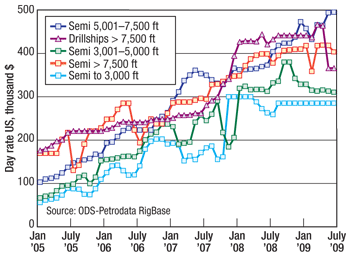 |
|
Fig. 6. Average US Gulf day rates: Selected floating rig classes earned rates, January 2005 to June 2008.
|
|
CANADA IS STAGNANT
Despite the best efforts of the Canadian and Atlantic provincial governments to boost exploration and production activities, the Canadian offshore rig market remains stagnant. At present, one jackup and two semisubmersible drilling units are working off Canada’s Atlantic coast. A drillship will join the others late in the year for four or five months, but by this time next year, it appears that only two rigs will be working off Canada, based on known contract commitments.
Day rates for these jobs are representative of rates in other markets for rigs with similar capabilities. The jackup is earning close to $300,000 per day, while the floaters are earning between $355,000 and $385,000 per day.
Seven operators have outstanding rig requirements off Canada, and four others have requirements for rigs to work off Greenland. For the most part, these are all short one- to two-well programs with estimated start dates after mid-2010, so whether or not this work actually materializes will depend on the economic climate and the operators’ ability to join together for multi-well programs to attract rig owners’ interest.
PEMEX PUSHES PRICES
Pemex has moved to take advantage of the current soft US Gulf rig market. In recent months, the Mexican state operator has managed to negotiate rates as much as $30,000 a day less for mat-supported jackups compared to rates agreed to earlier this year. Mat-supported rigs were being signed at rates around $90,000 per day early in the year; recent contracts have seen rates for some rigs as low as $63,000 per day.
In many ways, Pemex is the Gulf of Mexico jackup owner’s white knight. In the first half of the year, the Mexican state operator put one additional rig to work in five of six months (Fig. 7), and it still has outstanding tenders to fill. Of the 42 rigs in Mexican waters at the end of June, 32 were owned by US-controlled entities.
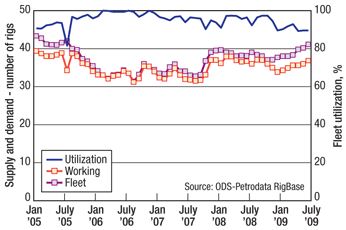 |
|
Fig. 7. Mexico MODU: Supply and demand for January 2005 to June 2009.
|
|
Pemex has four outstanding jackup requirements, all of which have estimated start dates in the last quarter of 2009 and first quarter of 2010. However, between now and then about 14 jackups currently working for Pemex will reach the end of their firm contract commitments, giving Pemex considerable leverage in day rate negotiations.
Pemex has one deepwater semisubmersible and four semis rated for 3,000-ft waters or less under contract and working at present. By mid-2010, two more deepwater semis will be working off Mexico, and a fourth will join the fleet in early 2011. The three semis joining the Pemex push to deep water over the next two years are all rated for water depths to 10,000 ft.
In addition, Pemex has one floating rig requirement that remains unfilled and, depending on the success of its deepwater efforts, may have additional floating rig requirements in the not-too-distant future.
GLOBAL CONTEXT
With the arguable exception of the US Gulf jackup market, the North American offshore rig market does not function in a bubble of its own, and factors that are likely to affect the worldwide offshore rig market have to be considered when undertaking a regional review.
In general, despite the global economic meltdown, the deepwater rig market remains strong. Some operators are signaling that they have sublet time available on deepwater rigs, and this effectively increases deepwater rig supply, which can affect utilization and, ultimately, day rates. However, all forecasts still point to a shortage of deepwater drilling rigs continuing for the foreseeable future, even with about 90 new floating rigs due to join the rig fleet over the next three years.
The mid-water floating rig market has softened, but has not experienced a wholesale decline, and it will cycle upward again as economic conditions improve.
The jackup market is a different story. Even before the economic crisis hit, the market was over-supplied, and many more new rigs are on the way. Between now and the end of 2010, 47 new jackups will be delivered; 42 of these have no firm contract commitments. Two of the 12 new jackups delivered so far this year still do not have contracts. Jackup owners, already beset by oversupply due to the rig construction boom that began a few years ago, face the hardest challenges. 
|
THE AUTHOR
|
| |
Tom Marsh is Vice President and Publisher at ODS-Petrodata, Inc., in Houston. He graduated from Texas A&M University’s Texas Maritime Academy in 1980 with a BS degree in marine transportation and an unlimited US Coast Guard Merchant Mariners license as Third Mate. After graduating, he sailed as Third Mate through the International Organization of Masters, Mates and Pilots. He joined ODS-Petrodata’s predecessor, Offshore Data Services, in 1987, and has since served in a variety of editorial and research roles. Prior to joining ODS, he worked for over five years as a marine surveyor and claims adjuster with an international energy insurance adjuster, involved in a wide variety of vessels engaged in offshore work.
|
|









